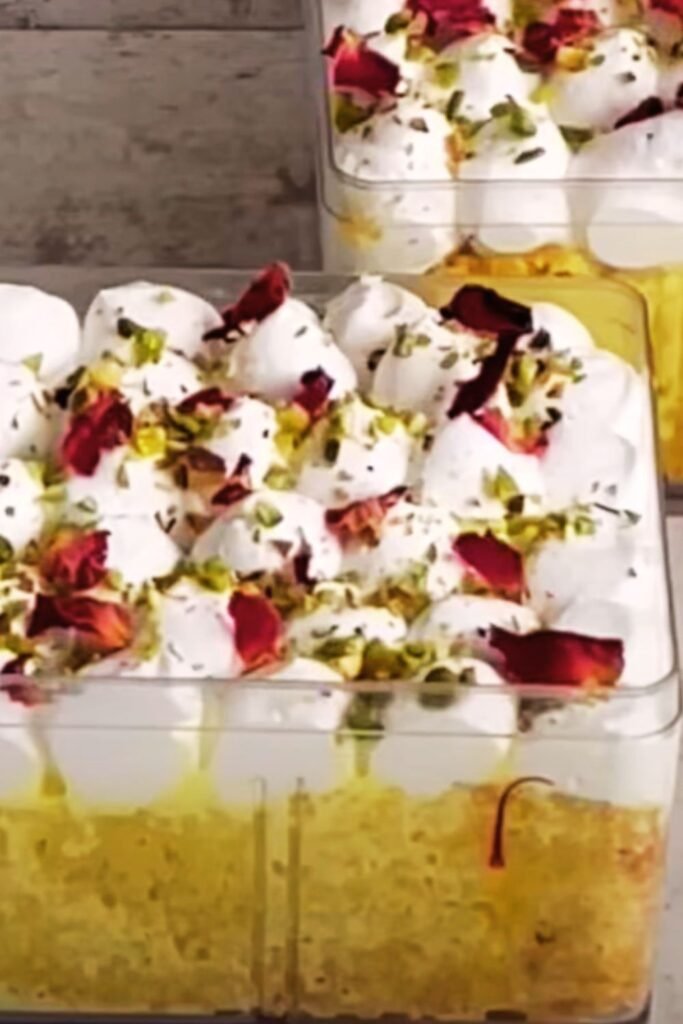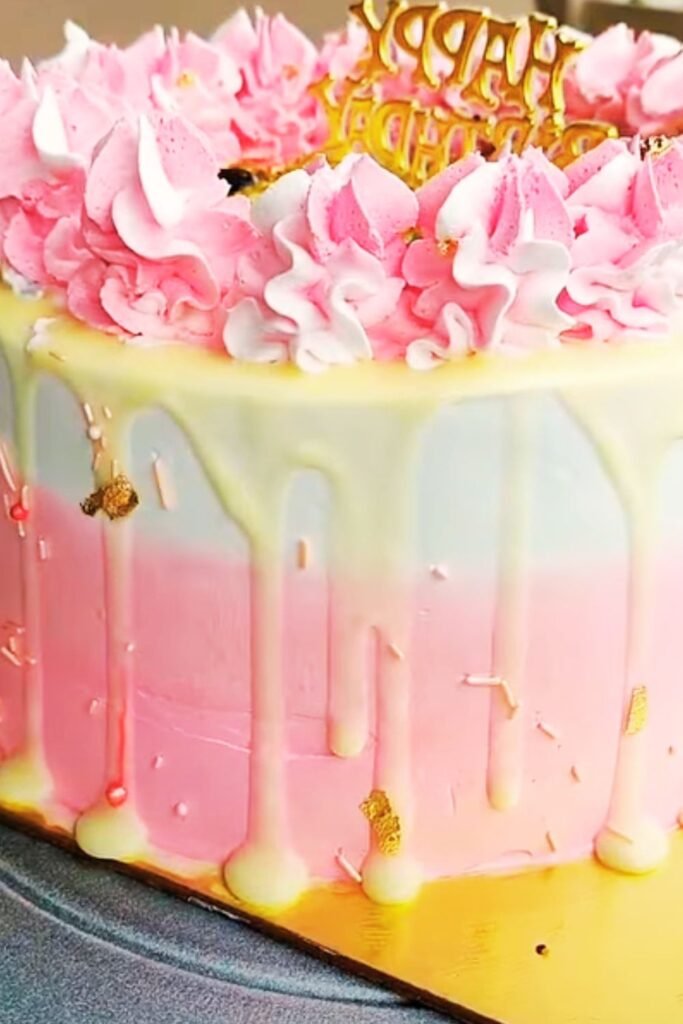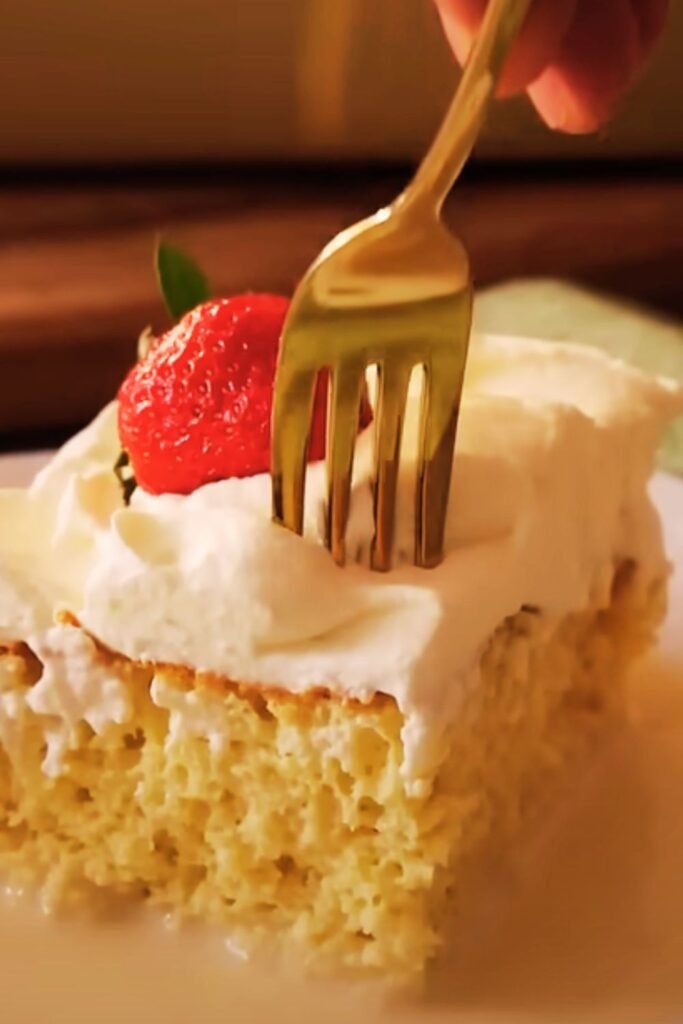There’s something magical about the moment when a spoonful of rose milk cake first touches your palate—the delicate sweetness, the subtle floral notes, and the silky texture that seems to dissolve instantly. This dessert has become my absolute favorite to make whenever I want to transform an ordinary evening into something special.
As someone who’s tested countless variations of this recipe in my home kitchen, I’ve discovered the perfect balance between the aromatic essence of roses and the creamy richness of milk. This isn’t just another trendy dessert—it’s a celebration of centuries-old flavor combinations reimagined for the modern palate.
The Enchanting History of Rose in Desserts
Long before vanilla became the world’s favorite dessert flavor, rose was the premier aromatic addition to sweets across the Middle East, South Asia, and parts of Europe. In my culinary journey, I’ve learned that rose essence has been used in desserts for thousands of years, particularly in Persian, Indian, and Turkish cuisines.
The rose milk cake we know today is a beautiful fusion dessert that combines the traditional tres leches concept with the fragrant elegance of rose water. While tres leches (three milks) cake originated in Latin America, the addition of rose elevates it to something truly special, bridging culinary traditions across continents.
I first encountered rose milk cake at a small family-owned bakery while traveling abroad. The baker noticed my fascination and shared that roses symbolize love and celebration in many cultures—precisely what this dessert brings to any table.
What Makes Rose Milk Cake Special?
What sets rose milk cake apart from other desserts is its unique combination of textures and flavors:
- Delicate Sponge: The base is incredibly light yet sturdy enough to absorb the milk mixture without collapsing
- Triple Milk Soak: A harmonious blend of evaporated milk, condensed milk, and heavy cream infused with rose
- Rose Essence: The floral notes that transport you to a garden in full bloom
- Subtle Sweetness: Unlike many desserts, rose milk cake balances sweetness with floral notes
- Versatile Serving Options: Perfect for everything from casual family dinners to elaborate celebrations
The cake’s pale pink hue, often enhanced with a drop of natural food coloring, makes it as beautiful to look at as it is delicious to eat. And the best part? Despite its sophisticated flavor profile, it’s surprisingly straightforward to make at home.
Essential Ingredients for Perfect Rose Milk Cake
Before we dive into the preparation, let’s talk about the key ingredients that make this cake special. I’ve experimented with various brands and varieties over the years, and these recommendations will help you achieve the best results.
For the Cake Base:
| Ingredient | Quantity | Notes |
|---|---|---|
| All-purpose flour | 2 cups (250g) | Sifted for a lighter texture |
| Granulated sugar | 1 cup (200g) | Superfine sugar works best |
| Baking powder | 1½ tsp | Must be fresh for proper rise |
| Salt | ¼ tsp | Enhances all flavors |
| Unsalted butter | ½ cup (113g) | Room temperature |
| Whole milk | ½ cup (120ml) | Room temperature |
| Eggs | 6 large | Separated, room temperature |
| Vanilla extract | 1 tsp | Pure, not imitation |
| Rose water | 1 tsp | High-quality food grade |
| Red food coloring | 1-2 drops | Optional, for pale pink color |
For the Three-Milk Soak:
| Ingredient | Quantity | Notes |
|---|---|---|
| Evaporated milk | 1 can (12 oz/354ml) | Provides richness without excess sweetness |
| Sweetened condensed milk | 1 can (14 oz/397g) | Adds silky sweetness |
| Heavy cream | 1 cup (240ml) | Creates luxurious mouthfeel |
| Rose water | 2 tbsp | Adjust to taste |
| Rose essence/extract | ¼ tsp | Optional, for stronger flavor |
| Pink food coloring | 1 drop | Optional |
For the Whipped Topping:
| Ingredient | Quantity | Notes |
|---|---|---|
| Heavy cream | 2 cups (480ml) | Well-chilled for best volume |
| Powdered sugar | ¼ cup (30g) | Stabilizes the whipped cream |
| Rose water | 1 tsp | Subtle flavor enhancement |
| Dried rose petals | 2 tbsp | For garnish, food grade only |
| Chopped pistachios | ¼ cup | For garnish and texture contrast |
| Fresh raspberries | ½ cup | Optional, for color and tartness |
Kitchen Tools You’ll Need
Having the right tools makes the process much smoother. Here’s what I use when making rose milk cake:
- Stand mixer or hand mixer: For perfectly whipped egg whites and cream
- 9×13 inch baking pan: Provides the ideal depth for soaking
- Mixing bowls: At least 3 different sizes
- Sifter: For perfectly light flour
- Rubber spatula: For gentle folding
- Wire cooling rack: Essential for proper cooling
- Fork or skewer: To poke holes for milk absorption
- Measuring cups and spoons: For accuracy

Step-by-Step Rose Milk Cake Recipe
Now that we have everything ready, let’s walk through the process of creating this ethereal dessert. I’ve refined these steps over dozens of attempts to achieve the perfect balance of flavor and texture.
Step 1: Preparing the Cake Base
- Preheat your oven to 350°F (175°C) and grease a 9×13 inch baking pan.
- Sift together flour, baking powder, and salt in a medium bowl. Set aside.
- Separate the eggs, placing whites in a large clean mixing bowl and yolks in another bowl.
- Beat egg whites until foamy, then gradually add ½ cup of sugar while beating until stiff peaks form. This typically takes 3-4 minutes on medium-high speed.
- In another bowl, beat the egg yolks with the remaining ½ cup sugar until pale and thick, about 2-3 minutes.
- Add butter to the yolk mixture and beat until well incorporated.
- Mix in vanilla extract, rose water, and food coloring (if using).
- Gently fold in the flour mixture alternating with milk, beginning and ending with flour. Be careful not to overmix.
- Gradually fold the beaten egg whites into the batter using a rubber spatula, maintaining as much air as possible.
- Pour the batter into the prepared pan and smooth the top.
- Bake for 25-30 minutes, or until a toothpick inserted in the center comes out clean.
- Allow the cake to cool in the pan for 10 minutes, then turn it out onto a wire rack to cool completely.
Step 2: Creating the Milk Soak
- In a large bowl or pitcher, combine evaporated milk, condensed milk, and heavy cream.
- Add rose water and rose extract (if using).
- Mix well and add a drop of food coloring if desired for a subtle pink tint.
- Place the mixture in the refrigerator to chill while the cake cools.
Step 3: Assembling the Cake
- Once the cake has cooled completely, return it to the baking pan.
- Using a fork or skewer, poke holes all over the cake surface. The more holes, the better the milk absorption.
- Slowly pour the milk mixture over the cake, focusing on even distribution.
- Cover with plastic wrap and refrigerate for at least 4 hours, preferably overnight. This waiting period is crucial!
Step 4: Finishing Touches
- Just before serving, prepare the topping by whipping cold heavy cream with powdered sugar and a touch of rose water until medium-stiff peaks form.
- Spread the whipped topping evenly over the soaked cake.
- Sprinkle with chopped pistachios and dried rose petals.
- If using, arrange fresh raspberries decoratively on top.

Pro Tips from My Kitchen to Yours
After making this cake countless times, I’ve gathered some insights that will help you achieve perfect results:
- Room temperature ingredients: Make sure eggs, butter, and milk are at room temperature for the best cake texture.
- Don’t rush the cooling: A completely cooled cake absorbs the milk mixture much more effectively.
- Quality rose water matters: Look for culinary-grade rose water from Middle Eastern or Indian grocery stores for the most authentic flavor.
- Patience with soaking: The longer you can let the cake soak (within reason), the more flavorful and moist it will be. I find 8-12 hours to be ideal.
- Chill serving utensils: For the cleanest slices, chill your knife or cake server before cutting.
- Balance the rose flavor: Rose can quickly become overwhelming—start with less and add more to taste.
Common Mistakes to Avoid
Even experienced bakers can encounter challenges with rose milk cake. Here are some pitfalls I’ve experienced and how to avoid them:
- Overmixing the batter: This deflates air bubbles and results in a dense cake. Fold gently!
- Using too much rose water: Rose water can easily overpower other flavors and make the cake taste like perfume. Start with less than you think you need.
- Not poking enough holes: More holes mean better milk absorption. Don’t be shy with that fork!
- Rushing the soaking process: The magic happens during those hours in the refrigerator—don’t cut this time short.
- Using artificial rose flavoring: Natural rose water provides a much more delicate and authentic flavor.
Variations to Try
Once you’ve mastered the classic version, consider these delicious variations:
Cardamom Rose Milk Cake
Add ½ teaspoon of freshly ground cardamom to the cake batter and another ¼ teaspoon to the milk mixture. This spice pairs beautifully with rose and adds wonderful complexity.
Saffron Rose Milk Cake
Steep a pinch of saffron threads in 2 tablespoons of warm milk for 10 minutes, then add to both the cake batter and the milk mixture for a luxurious golden hue and distinctive flavor.
Raspberry Rose Milk Cake
Fold 1 cup of fresh raspberries into the cake batter before baking, and add a tablespoon of raspberry preserves to the milk mixture for a fruity twist.
Coconut Rose Milk Cake
Replace ¼ cup of the flour with coconut flour, and substitute coconut milk for regular milk in the soak. Sprinkle toasted coconut flakes on top.
Serving Suggestions
Rose milk cake is versatile enough to suit many occasions. Here are my favorite ways to serve it:
- Afternoon Tea: Cut into small squares and serve with Darjeeling or Earl Grey tea
- Dinner Party Finale: Pair with fresh berries and a glass of rose-infused lemonade
- Festival Celebration: Garnish with extra rose petals and edible gold leaf for special occasions
- Summer Dessert: Add a scoop of pistachio ice cream on the side
- Brunch Star: Serve with a dollop of Greek yogurt and honey

Storage Instructions
If you’re lucky enough to have leftovers (I rarely do!), here’s how to store them:
- Refrigeration: Cover tightly with plastic wrap and store in the refrigerator for up to 5 days. The flavor actually improves over the first 2-3 days.
- Freezing: While possible, freezing isn’t ideal as it can affect the texture of the whipped topping. If you must freeze, do so without the topping and add fresh whipped cream after thawing.
- Make-Ahead Option: The cake can be baked and soaked up to 2 days before serving. Add the whipped topping just before presentation.
Nutritional Information
For those who are watching their intake, here’s the approximate nutritional information per serving (assuming 12 servings per cake):
| Nutrient | Amount per Serving |
|---|---|
| Calories | 420 |
| Total Fat | 24g |
| Saturated Fat | 15g |
| Cholesterol | 145mg |
| Sodium | 105mg |
| Total Carbohydrates | 48g |
| Dietary Fiber | 1g |
| Sugars | 40g |
| Protein | 7g |
Perfect Occasions for Rose Milk Cake
I’ve found that rose milk cake brings something special to these occasions:
- Spring and summer celebrations
- Mother’s Day brunch
- Bridal showers
- Garden parties
- Valentine’s Day dinner
- Eid festivities
- Anniversary celebrations
The delicate flavors and beautiful presentation make it ideal for any event where you want to impress without spending hours in the kitchen.
The Cultural Significance of Rose in Desserts
One aspect I find fascinating about cooking with rose is its rich cultural history:
In Persian cuisine, rose is considered a cooling ingredient, perfect for hot summer days. Indian desserts often pair rose with cardamom and nuts for celebratory sweets. Turkish delight, one of the world’s oldest confections, traditionally features rose as its primary flavor.
By incorporating rose into this modern cake, we’re connecting with thousands of years of culinary tradition while creating something uniquely ours.
Questions & Answers
Can I make rose milk cake without eggs?
Yes! I’ve successfully made this cake with egg substitutes. For best results, use ¼ cup of unsweetened applesauce plus ¼ teaspoon baking powder for each egg in the recipe. The texture will be slightly different but still delicious.
Where can I find food-grade rose water?
Look for rose water in Middle Eastern grocery stores, specialty food shops, or the international aisle of well-stocked supermarkets. Make sure it’s specifically labeled for culinary use, not cosmetic purposes.
Can I make this cake ahead for a party?
Absolutely! In fact, this cake tastes even better after 24 hours in the refrigerator. I recommend making it a day ahead and adding the whipped topping just before serving.
How strong is the rose flavor?
When made as directed, the rose flavor is present but subtle. If you’re new to floral flavors, start with half the amount of rose water and adjust to your preference.
What can I substitute for pistachios if there’s a nut allergy?
For a beautiful garnish without nuts, try toasted coconut flakes, candied rose petals, or crushed freeze-dried raspberries.
Can I use regular milk instead of the three-milk mixture?
The three-milk mixture is what defines this as a “milk cake.” While you could use just regular milk, you’d lose the signature moist, pudding-like quality that makes this dessert special.
How can I ensure my cake isn’t soggy?
There’s a fine line between pleasantly moist and unpleasantly soggy. Make sure your cake is completely cooled before adding the milk mixture, pour it on slowly, and refrigerate for at least 4 hours to allow proper absorption.
Can I make mini individual cakes instead of one large cake?
Yes! Bake the batter in cupcake tins or small ramekins, reducing the baking time to about 15-18 minutes. Soak each mini cake individually for best results.
Is it possible to make this cake less sweet?
You can reduce the sweetness by using less condensed milk and increasing the proportion of evaporated milk and heavy cream. Just maintain the same total volume of liquid.
How do I know if my rose water is good quality?
Quality rose water should have a delicate, natural rose scent without any chemical undertones. The ingredient list should be simple—water and rose essence or distilled roses.
A Perfect Ending to Any Meal
There’s something wonderfully satisfying about watching someone take their first bite of rose milk cake and seeing their expression change from curiosity to delight. The subtle floral notes, the creamy texture, and the beautiful presentation make this dessert truly special.
Whether you’re cooking for loved ones or treating yourself, this rose milk cake brings a touch of elegance to any occasion. The combination of traditional technique with unexpected flavors creates a dessert that’s both comforting and sophisticated—perfect for our modern tables.
I hope you’ll give this recipe a try and discover why rose milk cake has become one of my signature desserts. There’s something magical about transforming simple ingredients into something so enchanting, and I can’t wait for you to experience it for yourself.